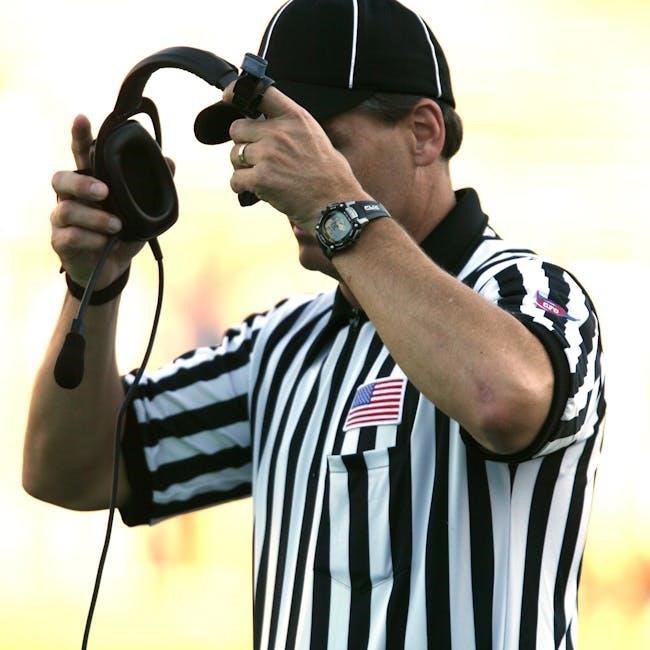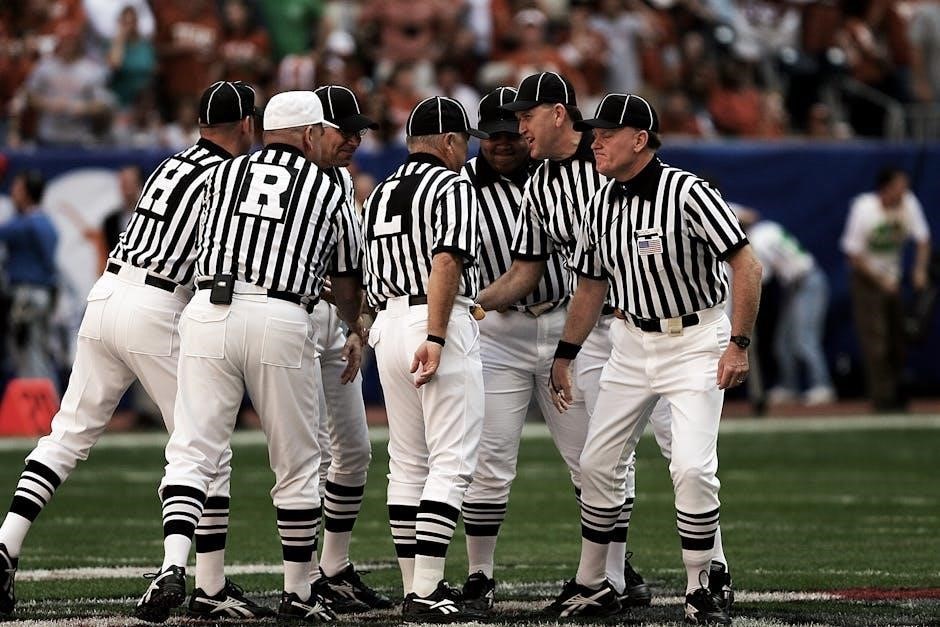The NFHS Football Rules Book is the official guide for high school football, ensuring consistent rules nationwide. It covers equipment, penalties, and gameplay, promoting safety and sportsmanship.
1.1. Overview of the NFHS and Its Role in High School Football
The National Federation of State High School Associations (NFHS) is the governing body for high school athletics, including football. It establishes standardized rules, promotes player safety, and fosters sportsmanship. The NFHS publishes annual rules books and resources, ensuring consistency across all states and schools.
1.2. Purpose of the Rules Book
The NFHS Football Rules Book aims to maintain fair play, reduce injury risks, and standardize competition. It provides clear guidelines for players, coaches, and officials, ensuring consistency and safety in high school football nationwide. Annual updates reflect evolving priorities in sportsmanship and player welfare.
1.3. Key Features of the 2024 NFHS Football Rules Book
The 2024 edition includes updates to penalty enforcement, safety protocols, and clarifications on fumble snap advancements. It emphasizes sportsmanship and injury prevention, with revised illustrations and digital access through NFHS AllAccess, ensuring officials and coaches stay informed on the latest rule changes for the upcoming season.

Structure of the NFHS Football Rules Book
The book is organized with a detailed table of contents, highlighting key updates and points of emphasis for the 2024 season, ensuring clarity and accessibility for users.
2.1. Table of Contents and Organization
The NFHS Football Rules Book features a logical table of contents, dividing rules into clear sections. It includes updates, penalty enforcement, equipment standards, and flag football guidelines, ensuring easy navigation for coaches, officials, and players.
2.2. Points of Emphasis for the 2024 Season
The 2024 season emphasizes player safety, sportsmanship, and rule updates. Key focuses include concussion protocols, excessive penalty enforcement reductions, and clarification of holding penalties. These points aim to enhance fair play and minimize injuries, aligning with the NFHS commitment to safe and equitable high school football competition.
2.3. The Role of the NFHS Rules Review Committee
The NFHS Rules Review Committee evaluates and finalizes rule changes proposed by individual sport committees. Chaired by the COO and composed of rules editors, it ensures consistency, safety, and fairness in high school football. The committee reviews all revisions before publication in the official rules book.

Major Rule Changes and Updates
The 2023 season introduced key updates, including revised holding penalty enforcement, changes to excessive penalty rules in Rule 10, and adjustments to fumble snap advancement regulations.
3.1. 2023 Changes to Holding Penalty Enforcement
The 2023 season saw significant updates to holding penalties, focusing on reducing excessive enforcements. Offensive fouls occurring behind the line of scrimmage were addressed to streamline gameplay and minimize confusion among officials and players.
3.2. Updates to Excessive Penalty Enforcement in Rule 10
Rule 10 updates in 2023 focused on reducing excessive penalty enforcements for offensive fouls occurring behind the line of scrimmage. This change aimed to eliminate unfair advantages and streamline gameplay, ensuring penalties align with the spirit of fair competition while maintaining player safety and game flow.
3.3. Revisions to Fumble Snap Advancement Rules
Revisions to fumble snap advancement rules eliminate prior restrictions, allowing for clearer gameplay and fair play. These changes ensure consistency and alignment with modern football standards, enhancing overall game integrity and addressing specific scenarios where fumble advancements were previously unclear or inconsistently enforced.

Equipment and Safety Regulations
The NFHS mandates strict equipment standards, including helmets meeting safety certifications and proper use of shoulder pads. Prohibited items are enforced to ensure player safety and fair play.
4.1. Helmet Safety Standards
Helmets must meet NOCSAE certification standards to ensure player safety. Proper fit and maintenance are required, with penalties for non-compliance. Reconditioning standards are strictly enforced to maintain helmet integrity and protect athletes from head injuries.
4.2. Rules for Player Equipment and Uniforms
Players must wear approved helmets, shoulder pads, and thigh guards. Uniforms must meet color and design standards, with numbers clearly visible. The field captain must be designated, and all gear must comply with safety regulations. Violations result in penalties or disqualification, ensuring fair and safe competition for all participants.
4.3. Prohibited Equipment and Penalty Enforcement
Prohibited equipment includes items deemed unsafe, such as metal cleats or altered helmets. Penalties for illegal gear include removal from the game and potential team sanctions. Officials enforce these rules strictly to maintain player safety and fair play across all high school football competitions.

Penalty Enforcement and Signals
Penalty enforcement involves clear referee signals and consistent rule application. Officials use hand signals and verbal calls to communicate infractions, ensuring fair and transparent gameplay.
5.1. Common Penalties and Their Definitions
Common penalties include holding, offsides, and pass interference. Holding involves grasping another player’s equipment to impede progress. Offsides occurs when a player aligns incorrectly before the snap. Pass interference disrupts a receiver’s route. These penalties are clearly defined in the NFHS Rules Book to ensure consistency and fair play.
5.2. Referee Signals and Communication
Referee signals are standardized to clearly communicate penalties. Hand signals and verbal calls ensure consistency. The referee’s decisions are final, maintaining game flow and fairness. Proper communication helps players, coaches, and fans understand rulings, aligning with the NFHS Rules Book to uphold integrity and clarity in high school football.
5.3. Incidental Contact vs. Penalty Calls
Incidental contact is minor and does not affect play outcomes, while penalties are called for actions that create unfair advantages or safety risks. Referees distinguish between the two to ensure fair play and player safety, adhering to NFHS guidelines for consistent enforcement of rules during high school football games.
Flag Football Rules and Updates
The official NFHS Flag Football Rule Book introduces updated rules, modifications, and key changes to ensure safe and fair play, enhancing the game experience for participants and officials.
The NFHS Flag Football Rule Book was officially released, adapting traditional rules for a safer, fast-paced game. It includes a 100-yard field, modified gameplay, and new rules to enhance participation and safety, while maintaining core football principles and sportsmanship values for all players.
6.2. Key Differences Between Flag and Tackle Football Rules
Flag football eliminates tackling, focusing on pulling flags for downs. It features a smaller field, simplified rules, and no three-man wedge restrictions. Blocking rules are relaxed, and fumble advancements are permitted, emphasizing speed and agility over physical contact, while maintaining core football strategies and fair play principles.
6.3. Field Dimensions and Gameplay Modifications
Flag football fields are smaller, typically 80 yards long with 20-yard end zones. Gameplay modifications include 7-on-7 formats, reduced quarters, and a mercy rule at 35-point differences. Rules simplify scoring and downs, emphasizing speed and agility while maintaining core football principles, ensuring a fast-paced and exciting alternative to tackle football.

The NFHS Football Officials Manual
The NFHS Football Officials Manual provides detailed guidelines for referees and officials, outlining roles, responsibilities, and rules for fair and consistent game management, ensuring player safety and adherence to regulations.
7.1. Roles and Responsibilities of Game Officials
Game officials enforce rules, manage gameplay, and ensure player safety. Referees call penalties, while other officials monitor specific areas like line judging or back judging. They communicate with coaches and players, maintaining fair play and sportsmanship. The NFHS Officials Manual outlines their duties, ensuring consistency and adherence to regulations during contests.
7.2. Rules for Penalty Acceptance or Declination
Penalty acceptance or declination is determined by the head coach’s designated representative. Rule changes, such as those in Rule 10, clarify when offensive fouls behind the line of scrimmage are enforced. The rules ensure fair outcomes, maintaining the integrity and flow of the game while prioritizing player safety and sportsmanship.
7.3. Illustrations and Clarifications in the Manual
The manual includes detailed illustrations to clarify complex rules, such as penalty enforcement and fumble snap advancements. Visual aids in Part 3 reflect updates from the NFHS Football Rules Committee, ensuring accurate interpretations. These visuals help officials, coaches, and players understand rule applications, enhancing consistency and fairness in gameplay execution and decision-making processes.
Digital Access to the NFHS Rules Book
The NFHS Rules Book is available digitally through NFHS AllAccess, offering convenient access to the official 2024 Football Rules Book PDF and other publications, enhancing accessibility for coaches, officials, and players nationwide.
8.1. Availability of the 2024 Football Rules Book PDF
The 2024 Football Rules Book PDF is now accessible via the NFHS website and AllAccess platform. This digital format ensures easy downloading and reference for coaches, officials, and players, providing up-to-date rules, points of emphasis, and illustrations for the 2024 season.
8.2. NFHS AllAccess Digital Publications
The NFHS AllAccess platform offers digital publications, including the 2024 Football Rules Book. This service provides easy access to rules, case books, and manuals, enabling users to search, download, and stay updated on the latest guidelines. It supports convenient access across multiple devices for coaches, officials, and players.
8.3. Benefits of the Digital Format
The digital format of the NFHS Football Rules Book offers enhanced accessibility, allowing users to access rules anywhere, anytime. It enables quick searches, bookmarking, and easy updates, ensuring officials, coaches, and players stay informed. The digital version also reduces storage needs and supports environmentally friendly access to essential guidelines.

Rules Interpretation and State Adoptions
Each state high school association interprets and adopts NFHS rules for their contests, ensuring consistent application and addressing local needs while maintaining national standards.
9.1. State Associations as Sole Interpreters of Rules
State high school associations have exclusive authority to interpret NFHS football rules for their contests. They ensure consistent application, address local needs, and adapt rules while maintaining the integrity of national standards to promote fair and safe competition.
9.2. Binding Rules Interpretations for Contests
Binding rules interpretations ensure consistency and fairness in contests. State associations, as the sole interpreters, apply these rules uniformly, addressing specific situations and maintaining the integrity of the game. The NFHS oversees this process to ensure interpretations align with national standards and promote fair play across all competitions.
9.3. Local Adaptations of NFHS Rules
Local adaptations allow state associations to modify NFHS rules to meet regional needs while maintaining national standards. These adjustments ensure flexibility and accommodate specific state or conference requirements, fostering a balanced approach to high school football governance and competition.

Key Points of Emphasis for Player Safety
Emphasizing concussion protocols, injury reporting, and minimizing inherent risks, the NFHS ensures player well-being through strict safety guidelines and sportsmanship standards in high school football.
10.1. Concussion Protocols and Injury Reporting
The NFHS mandates strict concussion protocols, requiring immediate removal of symptomatic players and medical clearance for return-to-play. Detailed injury reporting ensures transparency and accountability, prioritizing player health and safety in all high school football activities.
10.2. Rules to Minimize Inherent Risk of Injury
The NFHS has implemented rules to reduce injury risks, including stricter enforcement of holding penalties and excessive fouls. Flag football alternatives and revised fumble snap rules aim to enhance safety while maintaining competitive play, ensuring a balanced approach to injury prevention in high school football.
10.3. Sportsmanship and Fair Play Guidelines
The NFHS emphasizes respect and integrity in high school football. Rules prohibit unsportsmanlike conduct, promoting fair play and respect among players, coaches, and officials. Penalties for taunting, excessive celebrations, and disrespectful behavior ensure a positive athletic environment, fostering sportsmanship and camaraderie throughout the game.

Future of the NFHS Football Rules Book
The NFHS Rules Committee will continue to review and update rules annually, focusing on safety, fairness, and modern gameplay trends. Future updates may include new technologies and safety advancements.
11.1. Anticipated Changes for the 2025 Season
The NFHS Rules Review Committee is expected to introduce updates for the 2025 season, focusing on safety, fairness, and modern gameplay. Potential changes include adjustments to penalty enforcement, equipment standards, and rules clarifications. The committee will prioritize player safety and address emerging trends in high school football.
11.2. Evolution of Rules to Reflect Modern Gameplay
Rules evolve to align with contemporary football strategies and player safety needs. Recent updates include adjustments to holding penalties and excessive fouls, ensuring the game adapts while maintaining its traditional integrity. The NFHS continuously reviews and refines regulations to reflect modern techniques and minimize injury risks.
11.3. The Role of the Rules Committee in Shaping Future Updates
The NFHS Rules Committee plays a pivotal role in shaping future updates. Comprised of experts, the committee reviews feedback, assesses safety concerns, and proposes changes. Their collaborative efforts ensure rules remain relevant, fostering fair play and safety while addressing the needs of modern high school football.
The NFHS Football Rules Book is essential for maintaining the integrity and safety of high school football. It ensures fair play, promotes sportsmanship, and provides clear guidelines for all participants.
12.1. Final Thoughts on the Importance of the NFHS Rules Book
The NFHS Rules Book is indispensable for high school football, ensuring fairness, safety, and consistency. It provides clear guidelines, supports sportsmanship, and promotes player safety, making it a vital resource for coaches, players, and officials nationwide.
12.2. Encouragement for Coaches, Players, and Officials to Stay Updated
Staying updated with the NFHS Rules Book ensures coaches, players, and officials are informed about rule changes, safety protocols, and best practices. Regular reviews and training sessions help maintain consistency and uphold the integrity of high school football.
12.3. The NFHS Commitment to Fair and Safe High School Football
The NFHS prioritizes fair play and safety through updated rules and resources. By addressing equipment standards, penalty enforcement, and concussion protocols, the organization ensures a secure environment for athletes, fostering a culture of integrity and respect in high school football.



